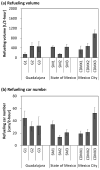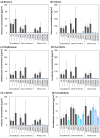Exposure/Risk Assessment of Employees in Gasoline Refueling Stations with and Without the Efficacy of Vapor Recovery Systems in Mexico
- PMID: 39857463
- PMCID: PMC11765004
- DOI: 10.3390/ijerph22010010
Exposure/Risk Assessment of Employees in Gasoline Refueling Stations with and Without the Efficacy of Vapor Recovery Systems in Mexico
Abstract
Concerns regarding the health risks associated with employe exposure to volatile chemicals during gasoline refueling necessitates rigorous investigation and effective countermeasures. This study aims to evaluate the efficacy of vapor recovery systems in mitigating exposure risks during gasoline refueling. Employee exposure to volatile organic compounds, aldehydes, carbon monoxide, and fine particulate matter (PM2.5) was assessed at gasoline stations with and without vapor recovery systems. Three stations each from the State of Mexico and Mexico City, equipped with gasoline vapor recovery systems, were compared with three stations in Guadalajara lacking such systems. The exposure concentrations (mean ± standard deviation) to benzene in Guadalajara, the State of Mexico, and Mexico City were 45 ± 29, 24 ± 20, and 18 ± 15 μg/m3, respectively, which were significantly higher than the background atmospheric concentrations at 1.6 ± 0.56, 0.72 ± 0.083, and 0.65 ± 0.14 μg/m3, respectively. Similarly, the exposure concentrations of toluene, ethylbenzene, and xylenes at gasoline stations were significantly higher than the background atmospheric concentrations. However, the exposure concentrations of formaldehyde and PM2.5 were similar to the background atmospheric concentrations. The excess cancer risks due to benzene exposure were estimated at 1.2-4.2 × 10-5, 0.63-2.2 × 10-5, and 0.46-1.6 × 10-5 (mean) and 0.42-1.5 × 10-4, 0.29-1.0 × 10-4, and 2.4-8.6 × 10-5 (maximum) in Guadalajara, the State of Mexico, and Mexico City, respectively. The risk to employees in gasoline stations was reduced by 47-61% in service stations with gasoline vapor recovery systems.
Keywords: BTEX; carbon monoxide; formaldehyde; gas station; personal exposure; vapor recovery system.
Conflict of interest statement
The authors declare no conflicts of interest associated with this manuscript.
Figures






References
-
- Agency for Toxic Substances and Disease Registry (ATSDR) Toxicological Profile for Xylene. U.S. Department of Health and Human Services; Atlanta, GA, USA: 2007. - PubMed
-
- Agency for Toxic Substances and Disease Registry (ATSDR) Toxicological Profile for Ethylbenzene. U.S. Department of Health and Human Services; Atlanta, GA, USA: 2010. - PubMed
-
- Agency for Toxic Substances and Disease Registry (ATSDR) Toxicological Profile for Toluene. U.S. Department of Health and Human Services; Atlanta, GA, USA: 2017. - PubMed
-
- Japan Society for Occupational Health (JSOH) Ethylbenzene. Sangyo Eiseigaku Zasshi. 2001;43:120–122. doi: 10.1539/sangyoeisei.KJ00001991672. (In Japanese) - DOI
MeSH terms
Substances
LinkOut - more resources
Full Text Sources
Medical

